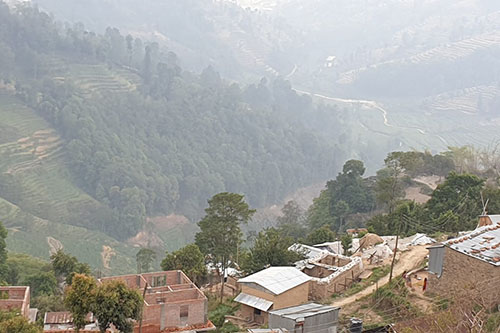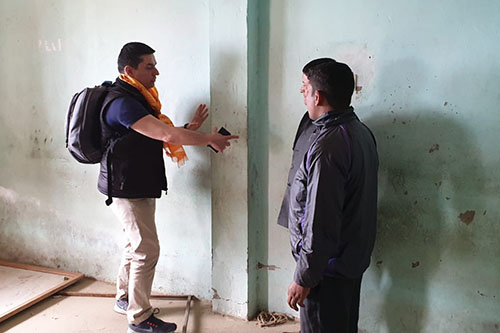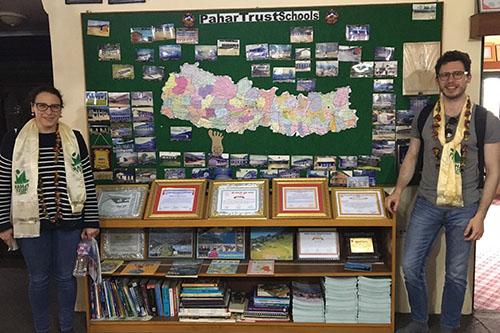
The landmark SAFER Nepal project draws on knowledge and experience from Nepal and around the world.

Professor Sextos visits a school in Nepal during the group's first visit to the country.

Dr Flavia De Luca and Dr Nicola Giordano from the University of Bristol visiting a school in Pokhara, Nepal.
In 2015, a devastating earthquake in Nepal resulted in the loss of 9,000 lives, 3.5 million people left homeless and entire neighbourhoods flattened.
To prevent destruction on the same scale again, the multidisciplinary team behind The SAFER Nepal Project has been working with local partners to improve the seismic safety and resilience of school and community buildings in Nepal.
"We cannot prevent earthquakes from happening, but we can devise smart, low cost solutions to mitigate seismic risk and enhance community resilience," said Anastasios Sextos, Professor of Earthquake Engineering at the University of Bristol and Principal Investigator of the SAFER Nepal project.
The landmark SAFER Nepal project, funded by EPSRC as part of UKRI's Global Challenges Research Fund, draws on knowledge and experience from Nepal and around the world, incorporating earthquake, structural and geotechnical engineers, seismologists, earth scientists, computer scientists, social scientists, stakeholders, decision-makers and more. By adopting a multidisciplinary approach, the aim is to build a better understanding of the seismic threat, identify existing vulnerabilities of the buildings, understand the needs and response of the communities affected, build databases and technology - all with the goal of developing real solutions that can be used in the local context.
"Collapsing buildings greatly increased the fatalities in 2015 and caused severe, long-term social and economic consequences. One challenge for Nepal, and other low-to-middle income countries, is finding affordable ways to make buildings more secure.
"One proven method of protecting new buildings in earthquake zones in developed countries is to rest them on sliding surfaces. This can be prohibitively expensive for many regions, but in Nepal, we're using that principle to investigate low-cost, culturally acceptable and locally-sourced ways of co-producing a similar system," said Professor Sextos.
In order to create a low-cost seismic isolation platform, a team led by Dr Nicholas Alexander, Associate Professor of Structural Dynamics, is using the seismic shaking table at the University of Bristol to investigate how replicas of Nepalese classrooms, strengthened with cost-effective techniques, perform under seismic excitation.
"Essentially the idea is if we can decouple the ground from the building, then if an earthquake happens, the ground will move but the building will remain unaffected," said Dr Alexander.
The team is developing a simple, state-of-the-art phone app so that local engineers can identify at-risk schools and enhance their safety. In partnership with National Society for Earthquake Technology (NSET), Nepal, and Kathmandu University and Institute of Engineering, Tribhuvan University the team has also been testing the engineering properties of locally-used building materials.
"We need to understand the engineering properties of local building materials, particularly stone. Working with local partners including NSET, we have been testing different types of mortar and design. What we learn will allow our partners to assess existing buildings and build safer structures in the future," said Professor Sextos.
All the research has been supported by workshops and on-site training so, with the aid of local and international partners, the team leaves behind the skills and expertise for communities to rebuild Nepal safely. Following this training from the project team (including Save the Children), local partners in Nepal are about to embark on a large campaign of field testing across the country.
Another important outcome of the project is the creation of the first database of seismic hazard in Nepal, including a unified database of the soils in Kathmandu. This provides vital information and data to inform and plan building projects.
In Nepal, SAFER is also working with government, academic institutions and NGOs, to strengthen resilience and post-quake structural health. Working with Save the Children, Nepal, there have been surveys of 160 school buildings and consultation with communities, focusing on school management committees, teachers and students. The aim is to understand the factors affecting resilience in order to tailor and target interventions to help children get safely back to school.
"It has to be something useful, tangible, applicable and low cost. The value of all these community engagements we have at all levels of the educational pyramid, means we can produce something meaningful for the people of Nepal," said Professor Sextos.
SAFER's guidelines for constructing schools in a novel, low-cost way, are due to be delivered in September 2020.
"We're essentially creating a framework that allows local decision-makers to plan for and react to another major earthquake and our collaboration will improve local design culture through new, safer, construction techniques and responses that can be easily replicated by other countries.
"Our focus has been to create tangible outcomes and influence how policy-makers approach building new schools in Nepal. Most importantly of all, we're helping protect lives, especially the lives of the young learners who will shape Nepal's future," said Professor Sextos.
Dr. Prachand Man Pradhan, Associate Professor and Head of the Department of Civil Engineering at Kathmandu University, said: "Collaboration between Kathmandu University and the University of Bristol has been highly productive and memorable for me. Particularly, I would like to thank Professor Anastasios Sextos for trusting me in the specific jobs to test various construction materials that are used in Nepal. In this regard, I also thank my team at Kathmandu University for helping me complete the job successfully. The SAFER project has been a wonderful and unforgettable experience to me. This project has not only been able to identify the mechanical properties and strengths of various construction materials, but also helped me learn the technological heights acquired by the University of Bristol. The results obtained should be ultimately useful for the earthquake resistant design and construction for new School Buildings to be constructed in Nepal."
Professor Prem Nath Maskey, from the Institute of Engineering at Tribhuvan University, said: "The collaboration among the universities and organizations of Nepal, UK and other countries coming together for the research project of SAFER (Seismic Resilience of Schools in Nepal) has been exemplary. The Impact of the project lies in the importance of research and collaboration on the seismic resilience of schools. The impact of the project will be reflected in the necessary strengthening and reconstruction of the schools for the future earthquakes and other disasters."






